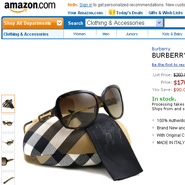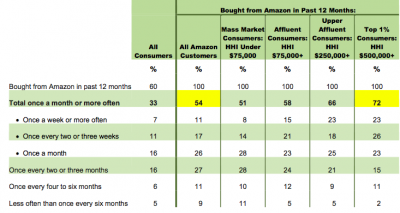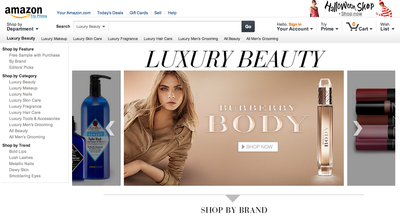 Amazon.com
Amazon.com
As Amazon’s penetration into high-income households becomes increasingly apparent, luxury brands are going to need to find new ways to avoid losing to their online-only competition, according to a new report by Shullman Research Center. Through pricing, convenience and selection, Amazon has seen its popularity skyrocket over the past two decades, and data in the report shows that its popularity is positively correlated with household income. The report suggests that luxury brands will have to double-down on efforts at providing things that Amazon cannot or will not provide.
"If you look on Amazon today, they sell a lot of mainstream clothing on that site," said Bob Shullman, founder/CEO, Shullman Research Center, New York. "If you order it — and I watch my daughter and my wife do it — they generally order two sizes, the size they think and either one above or one below — sometimes they order three — and they send back the other one or two. If you’re buying a $4,000 dress you probably want some seamstress or tailor standing there to make sure it really fits, but everything I’ve seen suggests to me that if Amazon can get its hands on the brands the people will buy it.
"What does Amazon basically provide you with? Convenience," he said. "I don’t enjoy going to stores. If I can buy something online and have it in a day or two and I can send it back in a day or two, how does that compare to schlepping to a store to deal with potentially incompetent staff who don’t want to serve you, may not have your size which makes it even more frustrating when you get there."
If you can't join them, beat them The Shullman Research Center’s report breaks consumer bases into four groups based on household income: “mass-market” consumers, the 58 percent of adults who make less than $75,000; “affluent” who make between $75,000 and $249,999, where some marketers believe affluence begins; the 3 percent of “upper affluent consumers” making between $250,000 and $499,999, where many marketers believe affluence begins; and the affluent top 1 percent, who make at least $500,000. Household income breakdown
The findings show that as income increases, so does the likelihood of shopping at Amazon, the frequency with which consumers shop at Amazon (see chart below) and both the percentage of consumers within the income bracket who are Amazon Prime members and who believe Amazon is better than other stores (59 percent of mass-market consumers but 83 percent of the top 1 percent).
Household income breakdown
The findings show that as income increases, so does the likelihood of shopping at Amazon, the frequency with which consumers shop at Amazon (see chart below) and both the percentage of consumers within the income bracket who are Amazon Prime members and who believe Amazon is better than other stores (59 percent of mass-market consumers but 83 percent of the top 1 percent).
 Chart courtesy Shullman Research Center
The lasting impression is that luxury brands will have to find ways to avoid losing consumers to and win them back from Amazon to counter the online store’s increasing household penetration and affinity with affluent consumers. Luxury brands are reluctant to allow Amazon to sell their goods because of the misalignment in brand values.
Chart courtesy Shullman Research Center
The lasting impression is that luxury brands will have to find ways to avoid losing consumers to and win them back from Amazon to counter the online store’s increasing household penetration and affinity with affluent consumers. Luxury brands are reluctant to allow Amazon to sell their goods because of the misalignment in brand values.
"One reason luxury brands don’t want to give anything to Amazon any level of control over their products [is] because if you give them control they may start discounting," Mr. Shullman said. "Because Amazon is basically convenience, breadth of opportunity and quick delivery, and the perception is that they sell it at a lower price.
"Luxury brands don’t want that," he said. "If there is a program that is out there, it’s probably more like an American Express one, or a credit card one, where you somehow earn points, and if you earn enough, you can then get your Louis Vuitton scarf or tie or whatever else it might be."
Still, a rewards program, while competitive, may not appeal to loyal customers.
When it comes to luxury marketers, properly rewarding a loyal customer without damaging the brand image could be challenging.
All in all, affluents do value rewards programs, but they do not feel like they have to be bribed by a luxury brand that they love. Affluents understand that they are paying for quality and the term “rewards” means something different to them than it does for other consumers (see story).
Some brands, particularly those selling large items, such as furniture, appliances and automobiles, have more security than others, as almost a third of Amazon consumers said they would not consider buying such items from the retailer, and the percentage of those who have items they would not consider purchasing from Amazon also increases with affluence (see chart below). However, most will need to find ways to compete with the convenience Amazon offers by letting consumers shop from home for almost everything they need. Chart courtesy Shullman Research Center
One customer quoted in the study said that one of the advantages of shopping on Amazon is that it does not have salesmen. However, another maligned that “if you don't know exactly what you are looking for, you usually can't find it."
This suggests that one area where luxury brands may improve in-store is to have helpful and knowledgeable salespeople who enhance the shopping experience. While only 38 percent of mass market consumers seek out superior service when shopping, the number jumps to 51 percent for affluent consumers and more than 60 percent for upper affluent consumers and the top 1 percent.
Chart courtesy Shullman Research Center
One customer quoted in the study said that one of the advantages of shopping on Amazon is that it does not have salesmen. However, another maligned that “if you don't know exactly what you are looking for, you usually can't find it."
This suggests that one area where luxury brands may improve in-store is to have helpful and knowledgeable salespeople who enhance the shopping experience. While only 38 percent of mass market consumers seek out superior service when shopping, the number jumps to 51 percent for affluent consumers and more than 60 percent for upper affluent consumers and the top 1 percent.
 Selected attitudinal statements
Relatedly, the report also shows that price becomes far less of a concern over quality as income rises for Amazon consumers. One potential route for luxury brands to consider may be as simple as raising prices and pushing tailoring and custom-fits, as Amazon’s consumers cannot see what they are buying or try on clothes before purchasing, giving them an advantage.
Other data suggests that refocusing advertising strategies and campaigns may help win over younger luxury consumers and the next generation. Thirty-one percent of upper affluent Amazon consumers say they usually buy the same brands their parents bought, the most of any market, compared to approximately 20 percent for each of the other three market segments. Attempts to instill brand loyalty may pay dividends in the future.
Selected attitudinal statements
Relatedly, the report also shows that price becomes far less of a concern over quality as income rises for Amazon consumers. One potential route for luxury brands to consider may be as simple as raising prices and pushing tailoring and custom-fits, as Amazon’s consumers cannot see what they are buying or try on clothes before purchasing, giving them an advantage.
Other data suggests that refocusing advertising strategies and campaigns may help win over younger luxury consumers and the next generation. Thirty-one percent of upper affluent Amazon consumers say they usually buy the same brands their parents bought, the most of any market, compared to approximately 20 percent for each of the other three market segments. Attempts to instill brand loyalty may pay dividends in the future.
 Amazon beauty store
Just as significantly, those in the upper two income segments are the most likely to be influenced by celebrity endorsements. Celebrity endorsements are already common, but pushing for more and higher profile stars may persuade consumers to open their wallets more.
Last but not least, more affluent consumers who shop at Amazon tend to look for exclusive products when shopping, with numbers approaching 40 percent for consumers who shop at Amazon making more than $250,000. A predisposition toward exclusives, a lowered concern for price, and celebrity endorsement sway combine for a great opportunity to lure affluent consumers with high-priced, celebrity-endorsed special- and limited-edition and exclusive items.
Other Amazon consumers quoted in the study cite ethical qualms with Amazon, preferring to shop locally or questioning its business practices. This reinforces what many luxury brands already know: consumers, especially young consumers, are increasingly concerned with a brand’s value. As Amazon continues to receive negative press for workplace conditions and business practices, luxury brands have an opportunity to polish their image and increase market share.
Out of the past
Amazon has previously made attempts to enter the luxury market.
Amazon beauty store
Just as significantly, those in the upper two income segments are the most likely to be influenced by celebrity endorsements. Celebrity endorsements are already common, but pushing for more and higher profile stars may persuade consumers to open their wallets more.
Last but not least, more affluent consumers who shop at Amazon tend to look for exclusive products when shopping, with numbers approaching 40 percent for consumers who shop at Amazon making more than $250,000. A predisposition toward exclusives, a lowered concern for price, and celebrity endorsement sway combine for a great opportunity to lure affluent consumers with high-priced, celebrity-endorsed special- and limited-edition and exclusive items.
Other Amazon consumers quoted in the study cite ethical qualms with Amazon, preferring to shop locally or questioning its business practices. This reinforces what many luxury brands already know: consumers, especially young consumers, are increasingly concerned with a brand’s value. As Amazon continues to receive negative press for workplace conditions and business practices, luxury brands have an opportunity to polish their image and increase market share.
Out of the past
Amazon has previously made attempts to enter the luxury market.
For example, in March it was reported that Amazon may be in talks to purchase British ecommerce site Net-A-Porter, according to rumors and reports.
The retail giant has been unsuccessful in entering the luxury industry in spite of attempts in recent years, and the potential acquisition could have been significant for the future of both companies. The impact that the purchase would have had on Net-A-Porter is unclear, but the luxury retailer has been not been profitable despite its popularity (see story).
Last November, a report concluded that Amazon would need to overhaul its image to attract luxury brands.
Despite Amazon’s efforts to attract luxury fashion labels, the online retailer’s official distribution rates sat at 16 percent, showing a general aversion to selling on the platform, according to a new report by L2. Luxury brands are very protective of their image, including retail, and they now have more options to turn to for ecommerce, whether their own direct-operated online stores or third party online retailers that specialize in fashion. If Amazon wants to woo more luxury brands, it will need to clean up its image (see story). Still, recent indicators suggest that Amazon may be closer to entering the luxury world than luxury brands are to staving off Amazon."In the New York men’s fashions event that just happened in July, I think there were 42 brands that were exhibiting and Amazon was one of the marquee sponsors," Mr. Shullman said. "It’s another attempt, in my mind, to get into fashion, luxury, beauty, all that good stuff.
"And what I read in the New York Times is that of the 42, 18 or 19 actually are sold on Amazon or one of Amazon’s other sites," he said. "People forget that Amazon has other companies. They’re changing the rules now."
Final Take Forrest Cardamenis, editorial assistant on Luxury Daily, New York